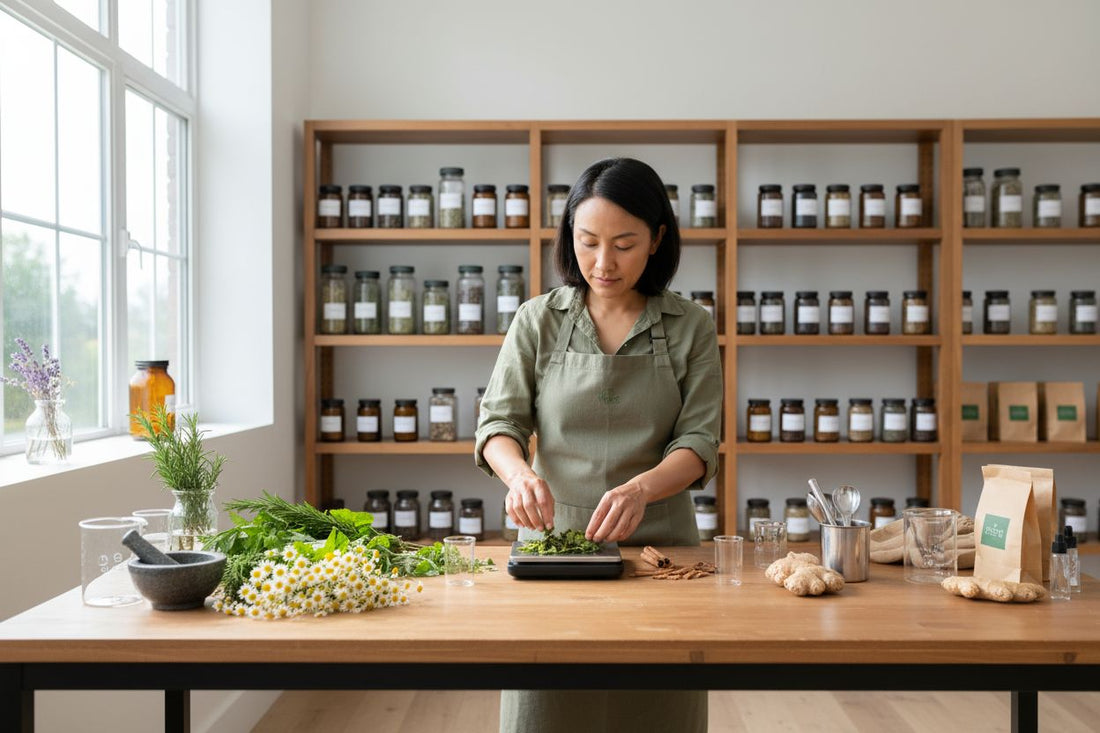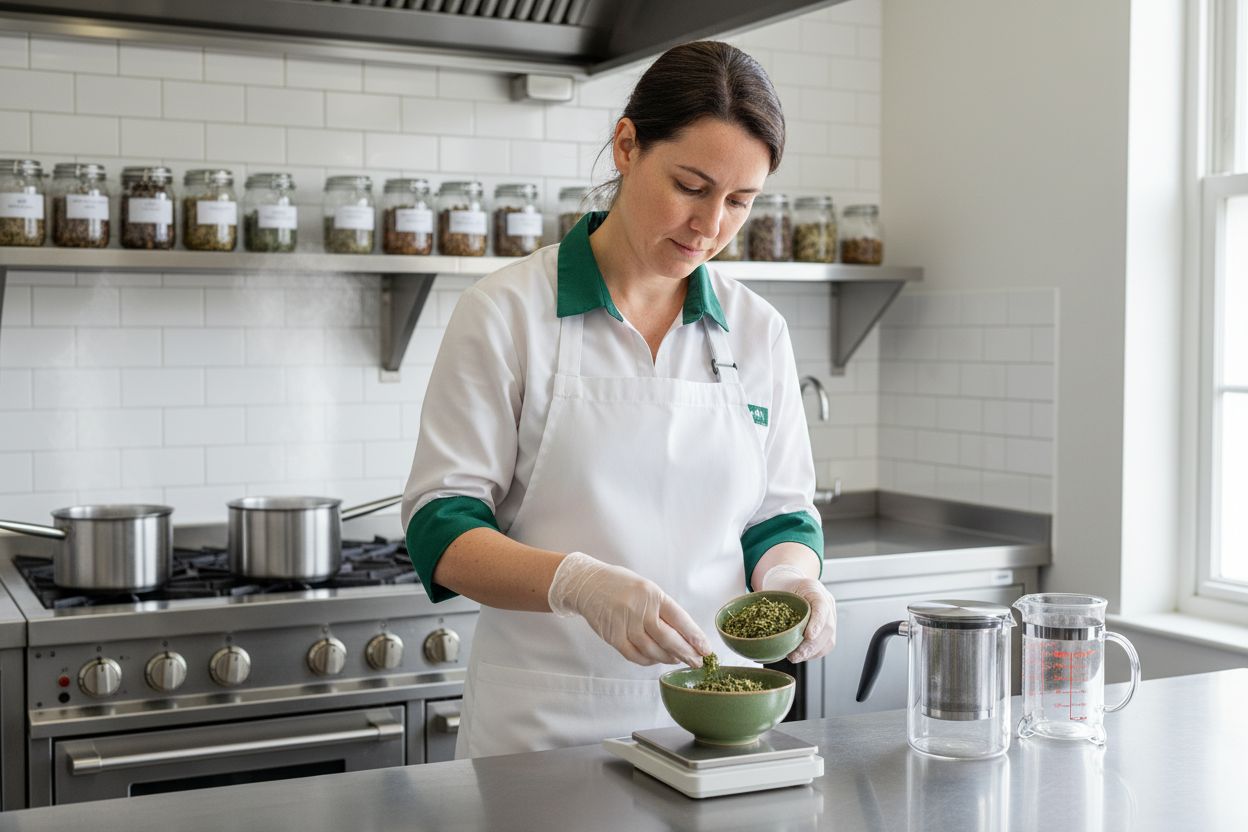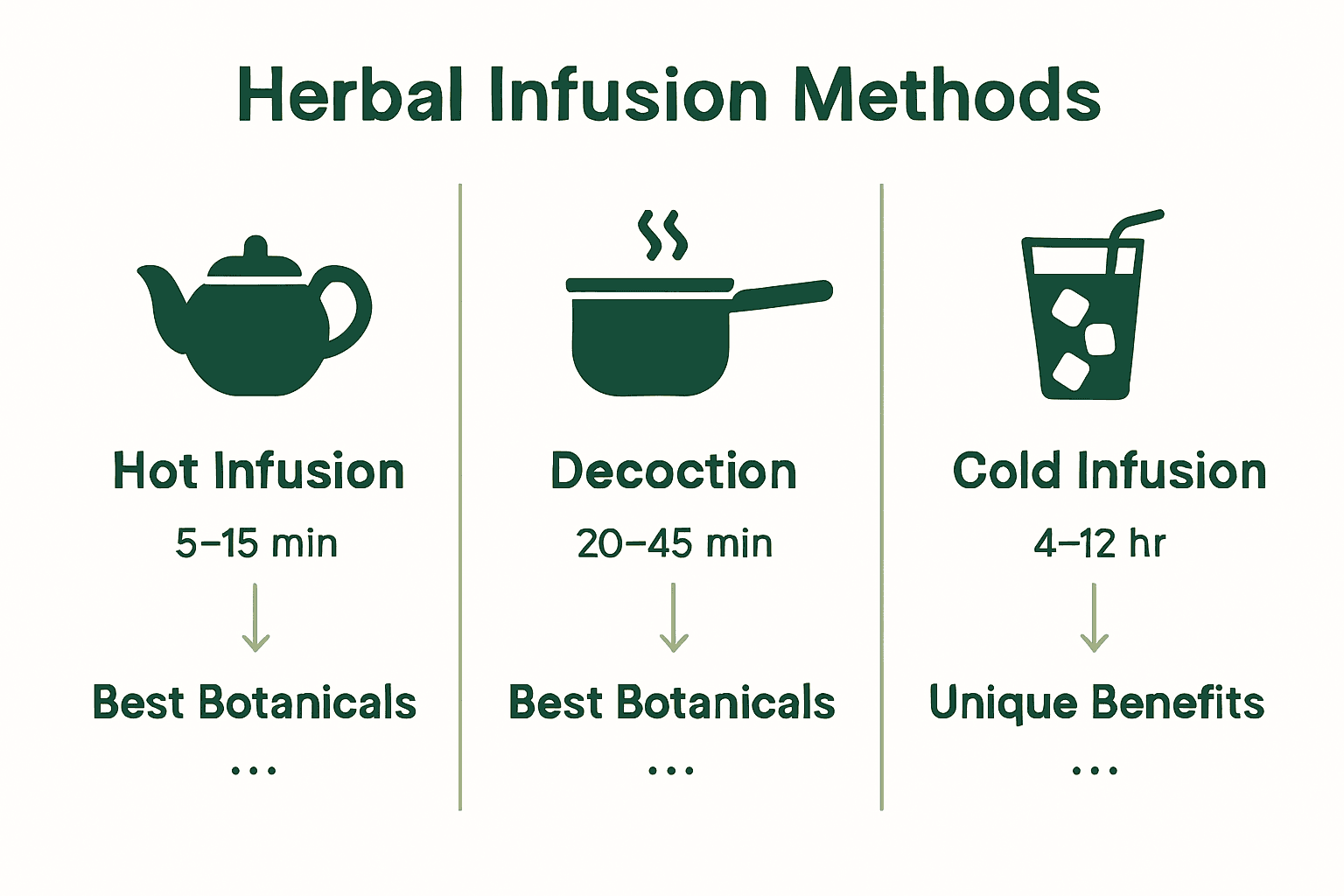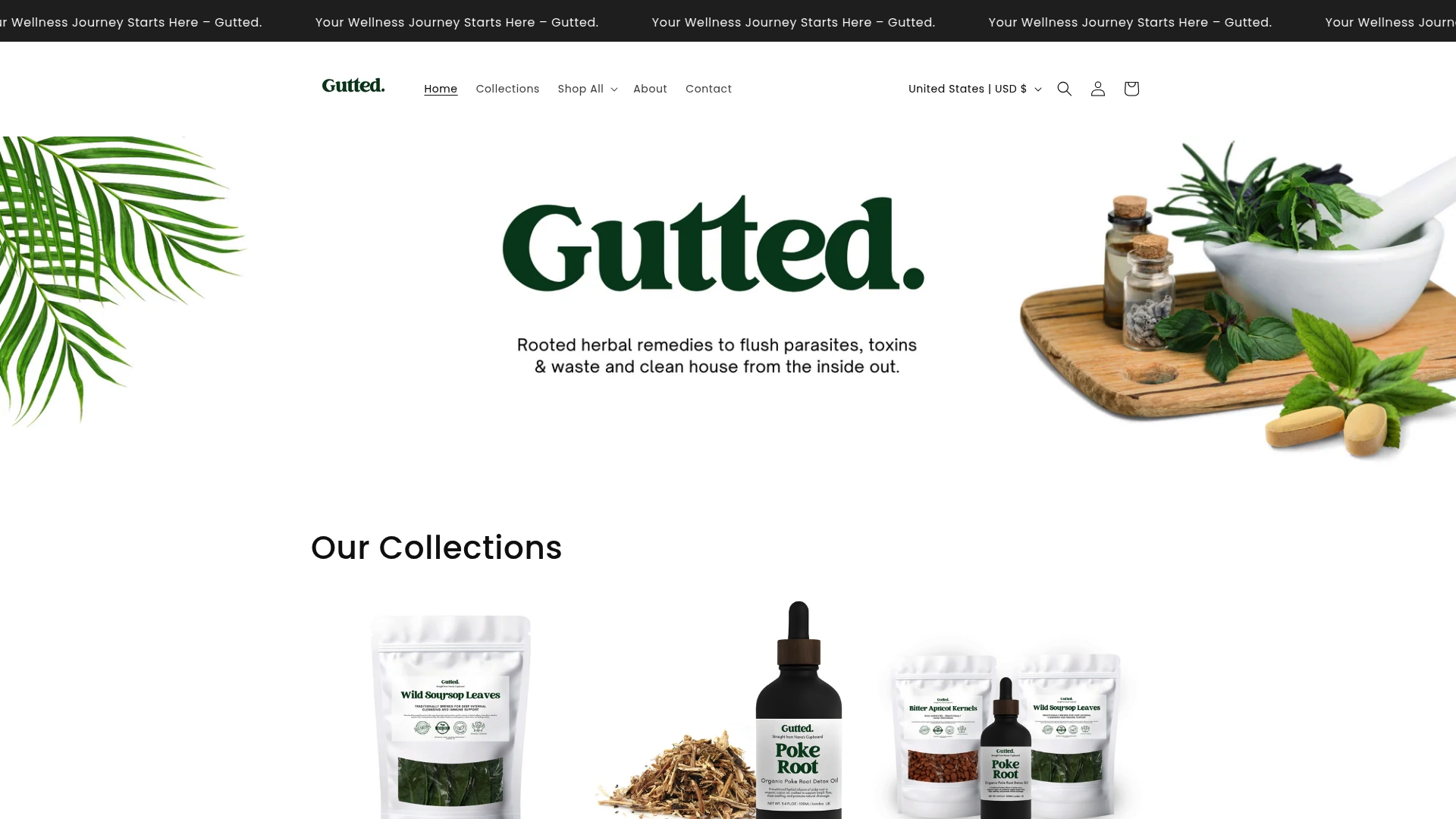
How to Make Herbal Infusions Naturally for Wellness
Did you know that over 80 percent of people worldwide rely on plant-based remedies as part of their healthcare? The growing interest in herbal infusions reflects a shift toward natural wellness strategies that anyone can practice at home. By understanding the right botanicals, preparation techniques, and safety guidelines, you can transform simple herbs into powerful infusions that support your health goals with confidence.
Quick Summary
| Key Point | Explanation |
|---|---|
| 1. Choose botanicals for specific health goals | Identify your wellness objectives, such as managing blood sugar or inflammation, and select appropriate herbs accordingly. |
| 2. Use proper preparation methods | Gather quality equipment and accurately measure herbs to maximize extraction of medicinal properties during infusions. |
| 3. Infusion methods impact extraction | Understand different infusion techniques, including hot, decoction, and cold infusion, to best suit the herbs’ characteristics. |
| 4. Strain and store properly | Use clean tools to strain your infusion and store it in cool, dark conditions to maintain potency and prevent spoilage. |
| 5. Perform quality checks before use | Conduct sensory evaluations for clarity and aroma before consuming herbal infusions, and ensure safe practices with herbs. |
Step 1: Select Potent Botanicals for Your Needs
Selecting the right botanicals transforms your herbal infusion from a simple beverage into a powerful wellness tool. Understanding how specific plants interact with your body helps you craft targeted blends that support your unique health goals.
Start by considering your primary wellness objective. Are you seeking to stabilise blood sugar levels? Reduce inflammation? Support digestive health? According to metabolomic research published in the Journal of Nutrition, different botanicals offer remarkable therapeutic potential. Read our guide on key herbs for natural detox to understand the nuanced benefits of various botanicals.
Research suggests some botanical powerhouses stand out for their remarkable properties. Cinnamon bark, mulberry leaves and blackberry fruits demonstrate impressive capabilities in managing metabolic processes. According to a study in Nutrients, these botanicals showed strong inhibition of carbohydrate-digesting enzymes, potentially helping regulate post-meal blood glucose levels.
When selecting your botanicals, prioritise fresh, organic sources. Look for vibrant colour, intact leaves or roots, and a strong aromatic profile. Quality matters immensely in herbal medicine. Mint species like Mentha spicata, for instance, consistently demonstrate high phenolic content and potent antioxidant properties in scientific analyses.
Pro Tip: Start with small quantities and observe how your body responds. Every individual’s biochemistry is unique.
Your next step will involve understanding precise preparation techniques to extract maximum therapeutic potential from your chosen botanicals. Careful selection sets the foundation for a truly transformative herbal wellness experience.
Step 2: Prepare Herbs and Set Up Equipment
With your botanical selection complete, it is time to transform those carefully chosen herbs into a potent and healing infusion. Proper preparation is the bridge between raw ingredients and therapeutic wellness.
Start by gathering your equipment. Professional herbalists recommend using stainless steel pots, French presses, teapots or dedicated herbal infusers. Avoid mason jars unless you are extremely careful about sterilisation. According to research from herbal preparation experts, you will want approximately 0.5 to 5 grams of dried herb per cup of water or one handful per quart.
Measurement matters significantly. For strong herbs, the standard ratio is one teaspoon per cup of boiling water. Steeping time is crucial research indicates 20 to 30 minutes allows maximum extraction of medicinal compounds. Different herbs require slightly different approaches. Explore our botanical detox guide to understand nuanced preparation techniques.
When working with multiple herb varieties, herbalists suggest a strategic approach. Decoct harder materials first like roots or bark by simmering them, then use that same water to infuse lighter herbs like leaves and flowers. This method ensures you capture the full spectrum of therapeutic properties.
Pro Tip: Always use clean equipment and filtered water to prevent contamination and preserve the herbs potent healing qualities.
Your next steps involve understanding precise steeping techniques that will unlock the maximum wellness potential of your herbal blend. Careful preparation transforms simple herbs into a powerful medicinal infusion.

Step 3: Infuse Herbs Using Optimal Methods
Infusing herbs is an art that transforms simple plant materials into potent wellness elixirs. Understanding different extraction methods will help you unlock the maximum therapeutic potential of your botanical blend.
Herbal practitioners recognise three primary infusion techniques. Hot infusion involves pouring boiling water over herbs and covering them to steep for 15 to 20 minutes. For deeper medicinal potency, you can extend steeping time up to several hours. Scientific research indicates that temperature and duration dramatically impact the extraction of healing compounds. Check out our essential detox herbs checklist to understand which herbs work best with specific infusion methods.
Decoction represents another powerful technique perfect for dense botanical materials like roots, bark and seeds. This method involves gently simmering herbs for 30 to 60 minutes. Research from phytotherapy studies reveals fascinating nuances in extraction. According to scientific analysis of mistletoe tea, different preparation methods can extract distinct medicinal constituents. Hot infusion preserves oleanolic and betulinic acids and flavonoids more effectively compared to room temperature maceration.
Cold infusion offers a gentler alternative especially suitable for mucilaginous herbs. By soaking herbs in room temperature water for 8 to 12 hours or overnight, you protect delicate plant compounds that might degrade under high heat. This method works wonderfully for herbs with sensitive therapeutic profiles.
Pro Tip: Always use filtered water and cover your infusion vessel to retain volatile oils and prevent contamination.
Your next step involves understanding how to strain and store your herbal infusion to maintain its therapeutic integrity. Each method offers unique benefits tailored to specific botanical characteristics.
Here’s a summary of the main herbal infusion methods:
| Method | Best For | Time Required | Key Benefits |
|---|---|---|---|
| Hot Infusion | Leaves Flowers |
15-20 min Up to several hours |
Quick extraction Preserves volatile oils |
| Decoction | Roots Bark Seeds |
30-60 min | Extracts dense compounds |
| Cold Infusion | Mucilaginous herbs | 8-12 hours | Preserves sensitive phytochemicals |
Step 4: Strain and Store Your Herbal Infusion
Now that you have crafted your carefully prepared herbal infusion, proper straining and storage become crucial to preserve its therapeutic potency and ensure optimal wellness benefits. The final steps of your herbal preparation can significantly impact the medicinal quality of your creation.
Carefully strain your infusion using a fine mesh strainer or layers of clean cheesecloth. Gently press the herbs to extract every last drop of medicinal goodness, but avoid squeezing too hard which might introduce bitter compounds. Professional herbalists recommend using clean glass containers for storage to prevent contamination and preserve the infusion’s delicate chemical profile. Learn more about herbal preservation techniques in our botanical wellness guide.
Storage is critical for maintaining your infusion’s therapeutic integrity. According to herbal safety research, refrigerated herbal preparations should be consumed within 24 to 48 hours to ensure maximum freshness and prevent bacterial growth. Glass containers with tight sealing work best store your infusion in the main compartment of your refrigerator, not the door where temperature fluctuates.
Temperature and light exposure can degrade the medicinal compounds in your herbal preparation. Choose dark glass containers if possible, and keep your infusions away from direct sunlight. Some delicate herbal preparations might lose their potency quickly, so always trust your senses if something seems off always discard an infusion that looks cloudy, smells unusual, or shows any signs of fermentation.
Pro Tip: Label your herbal infusions with the date of preparation and the specific herbs used to track their freshness and potency.
Your herbal wellness journey continues as you learn to integrate these powerful botanical preparations into your daily health routine. Each carefully crafted infusion represents a personal connection to natures healing wisdom.

Step 5: Test Quality and Use Safely
Testing the quality of your herbal infusion and understanding safe usage are critical steps in your wellness journey. Your carefully crafted botanical preparation deserves mindful consumption that respects both its healing potential and potential risks.
Quality begins with sourcing. According to herbal medicine research, water-based preparations must use herbs from reputable sources with verifiable certificates of authenticity. Sustainability and rigorous quality control are not optional they are essential for ensuring safety and therapeutic efficacy. Explore our comprehensive guide to herbal detox strategies to understand the importance of responsible herb selection.
Before consuming your infusion, perform a sensory quality check. Look for clarity, vibrant color, and a clean herbal aroma. Any unusual cloudiness, off-odors, or unexpected sedimentation are warning signs. Trust your senses they are your first line of defense in herbal preparation.
Safety requires careful consideration. Not all herbs are universally safe. Some potent botanicals like licorice, valerian, and comfrey may require professional guidance. Specific populations such as pregnant women and children need extra caution. Always research individual herb interactions and potential contraindications before consumption.
Pro Tip: Start with small quantities and observe your bodys response. Individual reactions can vary significantly with herbal preparations.
Organic sourcing and avoiding reactive cookware further enhance your infusions safety profile. Your herbal wellness journey is a personal exploration of natures healing wisdom balanced with informed, responsible practice.
Elevate Your Herbal Routine with Authentic Botanicals from Gutted
Crafting your own herbal infusions can feel overwhelming, especially when you want to select the right botanicals, prepare them safely, and unlock their true potential for wellbeing. If you crave pure, effective and expertly crafted herbal blends but struggle with finding high-quality ingredients or maintaining proper preparation methods, there is a simpler way. Experience the ease and assurance of expertly formulated wellness solutions tailored for detox, balance and natural vitality. Discover trusted detox blends and handcrafted herbal capsules in our Detox Herbs & Capsules collection, created with the highest standards for freshness and potency.

Ready to trust your herbal wellness to experts who fuse tradition with science? Shop our full range at Gutted™ and enjoy the confidence of nature’s wisdom, now within reach. Reconnect with your body’s healing intelligence and start your wellness journey today.
Frequently Asked Questions
How do I select the right botanicals for my herbal infusion?
Selecting the right botanicals involves identifying your primary wellness objective, such as stabilizing blood sugar or reducing inflammation. Start by researching specific herbs that align with your health goals and their potential benefits to choose the best ones for your blend.
What preparation techniques maximize the therapeutic potential of my herbal infusion?
To maximize the healing properties of your herbs, steep them appropriately based on their type. For example, use hot infusions for leaves and flowers, and decoction for dense materials like roots and bark, ensuring you steep for 20–30 minutes or as recommended.
How should I strain and store my herbal infusion to maintain its quality?
Strain your infusion using a fine mesh strainer or cheesecloth immediately after steeping, and store it in a clean glass container. Always refrigerate your infusion and consume it within 24 to 48 hours to ensure freshness and prevent bacterial growth.
What precautions should I take when testing the quality of my herbal infusion?
Perform a sensory quality check before using your infusion. Look for clarity and vibrant color, and ensure there are no off-odors or unusual cloudiness, which indicates that the infusion may not be safe to consume.
How can I safely use herbal infusions, especially if I am new to herbal preparations?
To use herbal infusions safely, start with small quantities, paying attention to how your body reacts. Research any specific herb interactions and potential contraindications, especially if you are pregnant or have underlying health conditions.
What are the different methods of infusing herbs and their specific benefits?
The primary methods include hot infusion for leaves, decoction for roots and bark, and cold infusion for mucilaginous herbs. Each method extracts different compounds effectively; for instance, hot infusion is quick and preserves volatile oils, while cold infusion helps retain sensitive phytochemicals.
